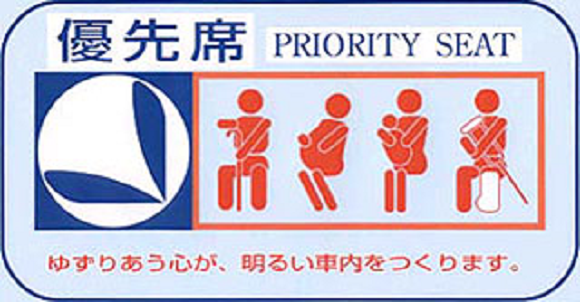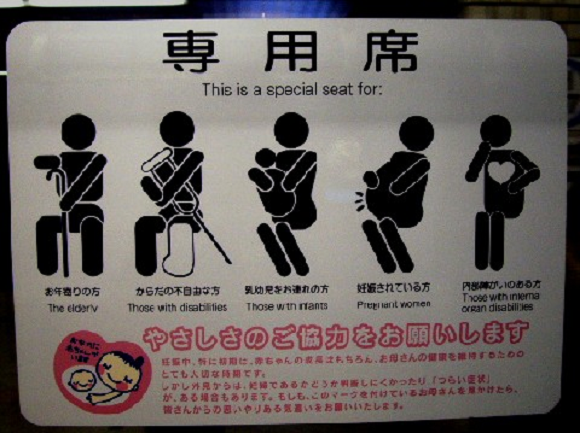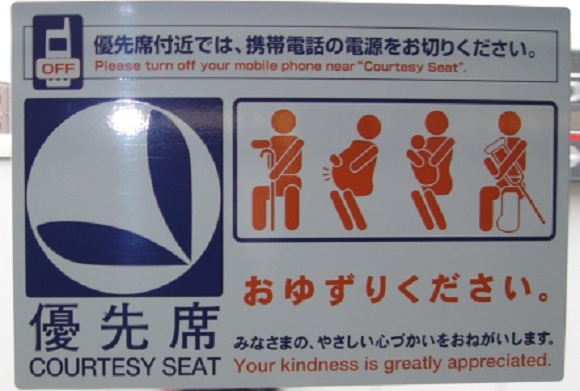With how crowded trains get during rush hour in Japan, finding an open seat can be like discovering an oasis in the desert, or a cold can of Ebisu beer in the fridge nestled behind a group of lesser brews. Oftentimes, though, you’ll step into the train and find every seat occupied.
While no one really likes standing for a 30- or 60-minute ride, for some elderly, pregnant, infant-accompanying, or handicapped passengers, that’s not just an unpleasant situation, but a painful, or even impossible, task. Those groups of people still have as much need for mobility as anyone else, though, so rail companies put up signs directing those passengers to special seats for them along the corner benches of each car.
It seems that able-bodied passengers in different parts of Japan react differently to these suggestions, though. Not only that, not everyone believes keeping those seats open is the right thing to do, and a lot of it has to deal with a subtle difference in the wording used in Tokyo and Sapporo.
Setting off the debate was a photo, shared by artist and Twitter user Robot Nozomi. Snapped while on the train in Sapporo, the largest city on Japan’s northernmost island of Hokkaido, it shows passengers crammed into every available patch of space inside the carriage, except one.
https://twitter.com/ROBOT_NOZOMI/status/498610577799802880
Along with the photo, Nozomi tweeted:
“In Tokyo, a lot of regular people sit in the priority seats, but in Sapporo, none of them do, even if the train is packed. Now I get it. This is how it’s supposed to be.”
As you’d expect from the show of conscientious kindness, many who saw the snapshot were impressed. “That’s wonderful,” earnestly commented one person, and a few of the locals were filled with a sense of pride. “That’s just how we do things here!” replied one Sapporo resident.
Still, not everyone was sold on the Sapporo-style seating standards. “I think that’s really kind and all, but even if I was injured or handicapped, that sort of atmosphere would make it hard for me to take a seat,” explained one self-conscious individual.
Others just didn’t see the upside of leaving seats empty if there was no one around who needed them. “That’s actually a nuisance for the other people on the train,” grumbled another detractor.
For some, there’s even a safety issue involved. “It can be dangerous to have too many people trying to occupy the same space,” he explained, asserting that spreading passengers out, in this case by having some sit in the special seats, would help people from crashing into one another in the case of an accident, sudden stop, or just as a result of the regular swaying of the train. This can turn into a bone-cracking human domino-tipping session surprisingly quickly.
Actually, there might be something more at play here than just the hustle and bustle of 13 million-person Tokyo versus the laid-back kindness of the smaller Sapporo and its two million residents. A lot of this could be chalked up to a difference in how those seats are labeled in the two cities.
If we take a look at the Japanese word Nozomi used in his tweet, he refers to the special seats as yuusenseki, literally “priority seats.”
▼ 優先席 / yuusenseki
That’s also what you’ll see written inside train and subway carriages in Tokyo, and most people interpret the term to mean that senior citizens, pregnant women, and the disabled should be given the seats ahead of any other passengers. Alternatively, if there’s no one around who fits into those groups, the priority seats are fair game, at least for the time being.
On the other hand, the trains in Sapporo apparently don’t call them yuusenseki. Instead, they’re senyouseki, the kanji characters for which mean “exclusive use seats.”
▼ 専用席 / senyouseki
There don’t seem to be any rules expressly prohibiting others from sitting in them, or levying fines against those who do. It’s even possible that whoever chose the name wasn’t even thinking about the stricter connotation it entails. Nevertheless, it looks like passengers in Sapporo take the designation seriously enough that if no one on the train belongs to one of the groups the senyouseki have been set aside for, then they should be left empty.
So who’s got the linguistic high ground? Well according to some people, it doesn’t really matter. In regards to Sapporo’s custom, one commenter felt, “This way of thinking, in and of itself, is admirable, but there’s no need to systematize it. It’s good manners to give your seat up for someone who needs it, and natural to sit down if no one does.”
Another open-minded individual concurred. “Whether you call them ‘priority’ or ‘exclusive use,’ what’s important is to think of the needs of the people around you.”
And as for what to call these seats in English? Well, it may be a little on the vague side, but we think this alternate translation for yuusenseki, used by the Tokyu rail network which runs through southwest Tokyo and Kanagawa Prefecture, perfectly encapsulates the spirit behind them.
Source: Jin, Twitter
Insert images: University of Tsukuba, Geocities, Nifty Cocolog




 Should healthy young men sit in Japanese trains’ priority seats for the elderly and pregnant?
Should healthy young men sit in Japanese trains’ priority seats for the elderly and pregnant? Video of foreign diplomat riding in Tokyo subway priority seat sparks manners debate【Video】
Video of foreign diplomat riding in Tokyo subway priority seat sparks manners debate【Video】 A reminder of why you shouldn’t be quick to judge who’s sitting in Japans’ priority train seats
A reminder of why you shouldn’t be quick to judge who’s sitting in Japans’ priority train seats Train etiquette poster features legendary Japanese folklore hero in an unusual plot twist
Train etiquette poster features legendary Japanese folklore hero in an unusual plot twist 10 times Japanese train passengers aren’t so polite【Survey】
10 times Japanese train passengers aren’t so polite【Survey】 Hayao Miyazaki says Happy New Year to Studio Ghibli fans with new art for Year of the Horse
Hayao Miyazaki says Happy New Year to Studio Ghibli fans with new art for Year of the Horse We revisited Sweets Paradise after a decade to see if Japan’s dessert buffet still delivers
We revisited Sweets Paradise after a decade to see if Japan’s dessert buffet still delivers Pizza Hut Japan’s hot lucky bags are perfect for a New Year’s pizza party
Pizza Hut Japan’s hot lucky bags are perfect for a New Year’s pizza party We found possibly the quietest Japanese-style hotel in Tokyo’s bustling Shinjuku district
We found possibly the quietest Japanese-style hotel in Tokyo’s bustling Shinjuku district Studio Ghibli releases new anime calendars for 2026 with heartwarming fan service
Studio Ghibli releases new anime calendars for 2026 with heartwarming fan service What’s so “Japan mind” about Häagen-Dazs’ new “Japan Mind” ice cream?
What’s so “Japan mind” about Häagen-Dazs’ new “Japan Mind” ice cream? Is China’s don’t-go-to-Japan warning affecting tourist crowds in Shibuya’s Don Quijote?
Is China’s don’t-go-to-Japan warning affecting tourist crowds in Shibuya’s Don Quijote? How to escape the Tokyo crowds with a trip to a hidden gem on a special Japanese train
How to escape the Tokyo crowds with a trip to a hidden gem on a special Japanese train Which of Japan’s Big 3 convenience stores has the best keema curry? 【Taste test】
Which of Japan’s Big 3 convenience stores has the best keema curry? 【Taste test】 Poké Ball breath mint holder series will keep you from being a smelly Pokémon otaku
Poké Ball breath mint holder series will keep you from being a smelly Pokémon otaku Starbucks Japan ready to get Year of the Horse started with adorable drinkware and plushies【Pics】
Starbucks Japan ready to get Year of the Horse started with adorable drinkware and plushies【Pics】 7-Eleven Japan’s ramen-cooking robot whipped us up a bowl of noodles【Taste test】
7-Eleven Japan’s ramen-cooking robot whipped us up a bowl of noodles【Taste test】 Cyberpunk anime meets traditional culture in Ghost in the Shell gold leaf Japanese changing screens
Cyberpunk anime meets traditional culture in Ghost in the Shell gold leaf Japanese changing screens 7 great places to see Mt. Fuji from without having to climb it
7 great places to see Mt. Fuji from without having to climb it Hello Kitty Choco Egg figures are an adorable trip through three periods of Japanese pop culture【Pics】
Hello Kitty Choco Egg figures are an adorable trip through three periods of Japanese pop culture【Pics】 Japan’s otoshidama tradition of giving kids money at New Year’s gets a social welfare upgrade
Japan’s otoshidama tradition of giving kids money at New Year’s gets a social welfare upgrade Lacquerware supplier to emperor of Japan and Pokémon team up for new tableware
Lacquerware supplier to emperor of Japan and Pokémon team up for new tableware Sumo Sanrio! Hello Kitty and pals team up with Japan Sumo Association for new merch【Pics】
Sumo Sanrio! Hello Kitty and pals team up with Japan Sumo Association for new merch【Pics】 Can a dirty butthole make you filthy rich in Japan? We’re starting a New Year’s lottery experiment
Can a dirty butthole make you filthy rich in Japan? We’re starting a New Year’s lottery experiment 7-Eleven Japan starts new temporary luggage storage service in over 300 branches
7-Eleven Japan starts new temporary luggage storage service in over 300 branches Disillusionment at Tsukiji’s tourist-target prices led us to a great ramen restaurant in Tokyo
Disillusionment at Tsukiji’s tourist-target prices led us to a great ramen restaurant in Tokyo Starbucks teams up with 166-year-old Kyoto doll maker for Year of the Horse decorations【Photos】
Starbucks teams up with 166-year-old Kyoto doll maker for Year of the Horse decorations【Photos】 Tokyo considering law requiring more trash cans following litter increase in heavily touristed area
Tokyo considering law requiring more trash cans following litter increase in heavily touristed area Tokyo’s Tsukiji sushi neighborhood asks tour groups to stay away for the rest of the month
Tokyo’s Tsukiji sushi neighborhood asks tour groups to stay away for the rest of the month Nintendo’s Kirby now delivering orders at Kura Sushi restaurants, but not in Japan
Nintendo’s Kirby now delivering orders at Kura Sushi restaurants, but not in Japan Tokyo event lets you travel back in time, for free, to celebrate 100 years since Showa era start
Tokyo event lets you travel back in time, for free, to celebrate 100 years since Showa era start Sanrio theme park in Japan announces plans to expand into a Sanrio resort
Sanrio theme park in Japan announces plans to expand into a Sanrio resort Japan may add Japanese language proficiency, lifestyle classes to permanent foreign resident requirements
Japan may add Japanese language proficiency, lifestyle classes to permanent foreign resident requirements Survey asks foreign tourists what bothered them in Japan, more than half gave same answer
Survey asks foreign tourists what bothered them in Japan, more than half gave same answer Japan’s human washing machines will go on sale to general public, demos to be held in Tokyo
Japan’s human washing machines will go on sale to general public, demos to be held in Tokyo Japan’s deadliest food claims more victims, but why do people keep eating it for New Year’s?
Japan’s deadliest food claims more victims, but why do people keep eating it for New Year’s? We deeply regret going into this tunnel on our walk in the mountains of Japan
We deeply regret going into this tunnel on our walk in the mountains of Japan Studio Ghibli releases Kodama forest spirits from Princess Mononoke to light up your home
Studio Ghibli releases Kodama forest spirits from Princess Mononoke to light up your home Major Japanese hotel chain says reservations via overseas booking sites may not be valid
Major Japanese hotel chain says reservations via overseas booking sites may not be valid Put sesame oil in your coffee? Japanese maker says it’s the best way to start your day【Taste test】
Put sesame oil in your coffee? Japanese maker says it’s the best way to start your day【Taste test】 No more using real katana for tourism activities, Japan’s National Police Agency says
No more using real katana for tourism activities, Japan’s National Police Agency says Starbucks Japan reveals new sakura drinkware collection, inspired by evening cherry blossoms
Starbucks Japan reveals new sakura drinkware collection, inspired by evening cherry blossoms Updated cherry blossom forecast shows extra-long sakura season for Japan this year
Updated cherry blossom forecast shows extra-long sakura season for Japan this year Japanese senior stabs younger man multiple times after seeing him sit in train’s priority seat
Japanese senior stabs younger man multiple times after seeing him sit in train’s priority seat The top 10 annoying foreign tourist behaviors on trains, as chosen by Japanese people【Survey】
The top 10 annoying foreign tourist behaviors on trains, as chosen by Japanese people【Survey】 Schoolboy offers elderly man seat on train, gets publicly berated for doing just that
Schoolboy offers elderly man seat on train, gets publicly berated for doing just that Is the new Shinkansen Train Desk ticket worth it?
Is the new Shinkansen Train Desk ticket worth it? Tokyo trains to ease cellphone restrictions near priority seats — but not during rush hour
Tokyo trains to ease cellphone restrictions near priority seats — but not during rush hour An often-forgotten part of Japanese train etiquette that we should all keep in mind
An often-forgotten part of Japanese train etiquette that we should all keep in mind Japanese railway sets up literal love seats with special seating for couples
Japanese railway sets up literal love seats with special seating for couples Messaging app LINE experiments with service to help pregnant women find seats on trains
Messaging app LINE experiments with service to help pregnant women find seats on trains Nozomi Shinkansen bullet train abolishes low-priced unreserved tickets during peak travel seasons
Nozomi Shinkansen bullet train abolishes low-priced unreserved tickets during peak travel seasons Shinkansen to permanently reduce number of inexpensive non-reserved seats on Nozomi trains
Shinkansen to permanently reduce number of inexpensive non-reserved seats on Nozomi trains Shinkansen makes unscheduled stop as elderly man whacks other passenger in the head with phone
Shinkansen makes unscheduled stop as elderly man whacks other passenger in the head with phone Japan travel alert: Cheapest seats on fastest Shinkansen will not be offered for Golden Week
Japan travel alert: Cheapest seats on fastest Shinkansen will not be offered for Golden Week Japanese train seats are cooler than you think
Japanese train seats are cooler than you think Is it OK to play with Pokémon card on the Shinkansen? A bullet train manners debate
Is it OK to play with Pokémon card on the Shinkansen? A bullet train manners debate Tokaido Shinkansen ending in-train food/drink sales for all non-first-class-passenger cars
Tokaido Shinkansen ending in-train food/drink sales for all non-first-class-passenger cars Beautiful Japanese sightseeing train will be unforgettable way to travel country’s north island
Beautiful Japanese sightseeing train will be unforgettable way to travel country’s north island
Leave a Reply